Review: Harry Potter and the Deathly Hallows
Review by Christopher G. Nuttall
There’s no easy way to say this, so I’ll be blunt. Deathly Hallows is easily the single worst book in the Harry Potter series. It steps outside the established conventions of the series and, in doing so, stumbles and falls. The plot holes – and the completely unnecessary introduction of the Deathly Hallows themselves – are not, on their own, enough to sink the book. Harry Potter is still, at least in part, a children’s series. But the endless series of mistakes – and regressions – made by the characters drag it down in flames. Compared to – say – The High Lord or The Hero of Ages, Deathly Hallows is a complete failure.
That does not make it impossible to read, although – in all honesty – I have only read it twice. I do not envy Rowling the task facing her, when she set up to complete the duology she started with Half-Blood Prince. Satisfying everyone would have been impossible, particularly as there were dozens of plot elements up in the air. But, at the same time, I feel that she allowed the series to conclude in a very poor manner. Deathly Hallows is very small beer indeed.
Back at his relatives for one final time, waiting for the wards to drop the moment he comes of age, Harry Potter is whisked away by the Order of the Phoenix as the Death Eaters begin their assault on his family home. (It’s nice to see the Order actually taking care of the Dursleys, although I suspect that no one actually enjoys the experience.) Attending Bill Weasley’s wedding, Harry hears that the Ministry of Magic has fallen to Voldemort and the Wizarding World is now under his rule. Snape, Dumbledore’s murderer, is now Headmaster of Hogwarts. He and his friends, Ron and Hermione, set off to find the 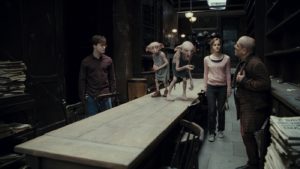 remaining pieces of Voldemort’s soul, the key to his immortality. At Sirius’s former home, now Harry’s, they discover that one piece – Slytherin’s Locket – was stolen from the house (by an Order member, no less) and eventually confiscated by Umbridge.
remaining pieces of Voldemort’s soul, the key to his immortality. At Sirius’s former home, now Harry’s, they discover that one piece – Slytherin’s Locket – was stolen from the house (by an Order member, no less) and eventually confiscated by Umbridge.
Invading the Ministry of Magic, the trio steal back the locket and run. Unfortunately, in a piece of sheer stupidity, they make the decision to wear the damn locket, giving it a chance to influence them for the worse. Their arguments grow more and more heated until Ron, wearing the locket, storms into the night. Harry and Hermione continue the quest, alone, finding out more about Dumbledore’s past in the process. They are eventually attacked by Voldemort’s snake and hide in the Forest of Dean, where they find the Sword of Gryffindor – and Ron. Taking up the sword, and facing his insecurities for the final time, Ron destroys the locket.
The trio, now reunited, travel to a friend’s house, where they are told the legend of the Deathly Hallows, three magic artefacts – the unbeatable Elder Wand, the Invisibility Cloak worn by Death himself and the Resurrection Stone. Unfortunately, they are betrayed and taken to Malfoy Manor. Luckily, with some help, they escape – Peter Pettigrew, making the decision, not to alert Voldemort that they’re escaping, is summarily strangled by his silver hand. Returning to Hogwarts, they find another piece of Voldemort’s soul and rally the troops, liberating the school from Voldemort’s servants. However, the Death Eaters lay siege to the castle.
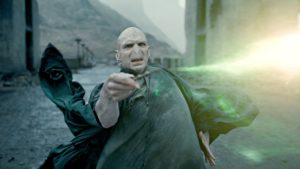 Voldemort, now in possession of the Elder Wand, feels that the wand is not serving him properly. Figuring that it didn’t come to him through victory over the previous owner, he mortally wounds Snape … who lives long enough to ensure that Harry knows that Snape was on Dumbledore’s side all along, that he and Harry’s mother were friends before their falling-out … and that Harry himself is carrying the last piece of Voldemort’s soul. For Voldemort to die, Harry must die too. Harry walks up to Voldemort; Voldemort kills him.
Voldemort, now in possession of the Elder Wand, feels that the wand is not serving him properly. Figuring that it didn’t come to him through victory over the previous owner, he mortally wounds Snape … who lives long enough to ensure that Harry knows that Snape was on Dumbledore’s side all along, that he and Harry’s mother were friends before their falling-out … and that Harry himself is carrying the last piece of Voldemort’s soul. For Voldemort to die, Harry must die too. Harry walks up to Voldemort; Voldemort kills him.
Harry finds himself within a ghostly representation of King’s Cross Station, where he meets Dumbledore’s soul. Dumbledore tells him that Voldemort was the only one who could remove the piece of his soul from Harry’s scar; the soul took the brunt of the curse, allowing Harry to go on to the next world or – if he wishes – return to Earth. Harry chooses to return, joining the defenders in battle as the Death Eaters invade the castle. Voldemort makes one final strike against Harry, but the Elder Wand refuses to land the killing blow. Instead, the spell rebounds. Voldemort dies, this time for good.
And then there is a time-skip to the epilogue. But we are assured that all is well.
A boarding school story, by its very nature, is framed by the structure of life at a boarding school. There are classes and teachers and covert sneaking around after the lights are out; there is everything from jolly midnight feasts to exaggerated sessions of corporal punishment. The first six books in the Harry Potter series followed the same basic structure, using Hogwarts as the base for adventure. Deathly Hallows does not, by and large. By taking the trio out of the school more or less completely – it certainly doesn’t show them taking lessons – the structure fell apart. On one hand, it’s good to see more of the wider world; on the other, the story only showcases the trio’s ignorance. They are operating blind and it shows. I can’t help thinking that the story would have worked better if they’d spent most of their time at Hogwarts, covertly resisting Headmaster Snape – who, as we now know, was a good guy all along – and sneaking out to find the pieces of Voldemort’s soul before it was too late. Voldemort might have thought that Snape was keeping Harry prisoner at Hogwarts – and forcing him to undergo more potions classes – and never given his young nemesis a second thought.
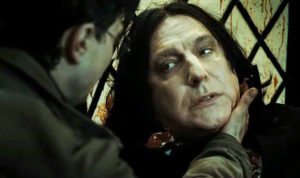 Indeed, there were times during the story when I wondered if Ron was secretly working with Snape. I thought it was almost certain when Snape covertly led Harry and Hermione to the sword – and Ron. It might have made sense to have Ron abandon his friends, under cover of an argument, long enough to consult with the older wizard about ways to destroy the locket. But it was not to be.
Indeed, there were times during the story when I wondered if Ron was secretly working with Snape. I thought it was almost certain when Snape covertly led Harry and Hermione to the sword – and Ron. It might have made sense to have Ron abandon his friends, under cover of an argument, long enough to consult with the older wizard about ways to destroy the locket. But it was not to be.
Instead, we are treated to a story that relies upon our heroes being idiots. They know that the pieces of Voldemort’s soul are capable of influencing and eventually controlling those who keep them too close. Ginny was possessed in Chamber of Secrets, Dumbledore was influenced between Order of the Phoenix and Half-Blood Prince (sealing his doom) … so what were they thinking? They should have known better than to let anyone, particularly Ron (who has already shown his weakness when it comes to mind control), to wear the bloody thing. And even if we discount that mistake, we have problems caused by their sheer ignorance. Why didn’t they try to find out how to destroy the soul-pieces before it was too late? You’d think Dumbledore would remind Harry about what happened in Chamber well before his death at the end of Half-Blood Prince.
There are some nice moments in the book. It’s good to see Ron and Hermione finally get together, particularly after a meeting of the minds. Neville, too, steps up and plays an important role in Voldemort’s defeat. And Harry, as block-headed as he is (and I probably shouldn’t have expected it to change after six books), still plays the hero when he walks up to Voldemort fully expecting to die so that Voldemort will die too.
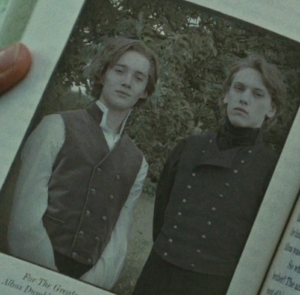 We also learn more about Dumbledore’s past, for better or worse, including his homosexual relationship (it isn’t clear if it was actually consummated) between him and the Dark Wizard Grindelwald. It’s interesting to see how Dumbledore was once as ambitious as Tom Riddle, only to learn – the hard way – that such ambitions come with a price. (Dumbledore’s noted apathy to Slytherin House may come from a fear of ambition – either way, Dumbledore made no attempt to guide Tom Riddle before it was far too late.) We knew Dumbledore was a dodgy character – this was noted right back in the first book – but Deathly Hallows shows that he was a consummate manipulator. Rowling plunges Dumbledore into controversy – and leaves us wondering what sort of man he really was – even as she liberates Snape from all doubt. It’s actually quite well handled.
We also learn more about Dumbledore’s past, for better or worse, including his homosexual relationship (it isn’t clear if it was actually consummated) between him and the Dark Wizard Grindelwald. It’s interesting to see how Dumbledore was once as ambitious as Tom Riddle, only to learn – the hard way – that such ambitions come with a price. (Dumbledore’s noted apathy to Slytherin House may come from a fear of ambition – either way, Dumbledore made no attempt to guide Tom Riddle before it was far too late.) We knew Dumbledore was a dodgy character – this was noted right back in the first book – but Deathly Hallows shows that he was a consummate manipulator. Rowling plunges Dumbledore into controversy – and leaves us wondering what sort of man he really was – even as she liberates Snape from all doubt. It’s actually quite well handled.
But there are some other, weaker, moments. Ron facing his insecurities is, IMHO, the sort of thing that should have been done earlier. (That I thought had been done earlier.) Snape deserved to play a far greater role in the plot than he did – and he should have lived longer, at least long enough to make proper amends with Harry. Draco, and his family, come across as weaklings … although, ironically, Rowling might well have been making a very valid point about such people always being weaklings at heart. Again, we should have seen more of them. And Peter Pettigrew’s quick reappearance and equally quick demise was a giant missed opportunity.
And, perhaps worst of all, is Hermione’s decision to ‘deal’ with her parents by wiping their memories and sending them to Australia. And, once again, she suffers no (canonical) consequences from crossing the moral event horizon.
But the greatest problem is the Deathly Hallows themselves. They are simply never mentioned, as such, throughout the previous six books. We are given no reason to believe that there is anything special about Harry’s invisibility cloak, save for it being a Potter family heirloom. And then, they – and the whole business about wands changing allegiance – appeared out of 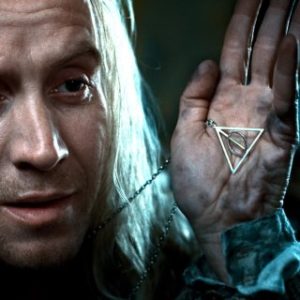 nowhere. They just don’t fit with the remainder of the universe Rowling showed us. I honestly thought that the whole story was nonsense, with Dumbledore convincing Voldemort that the Elder Wand existed … and convincing him to waste time chasing it while Harry and his friends laid their plans against him. But the Deathly Hallows are real …
nowhere. They just don’t fit with the remainder of the universe Rowling showed us. I honestly thought that the whole story was nonsense, with Dumbledore convincing Voldemort that the Elder Wand existed … and convincing him to waste time chasing it while Harry and his friends laid their plans against him. But the Deathly Hallows are real …
A satisfactory ending to a series should flow logically from the earlier books. The Hero of Ages works perfectly – I would go so far as to say brilliantly – because everything that happens within that tome draws on groundwork laid within the earlier books. And I can envisage a handful of more convincing endings to the Harry Potter universe that would draw on elements from the earlier books. We would not even need to remove the ‘pieces of Voldemort’s soul’ plot, although we really would have to do something about Harry’s tendency to believe Dumbledore, despise Snape and basically let Hermione – who is nowhere near as clever as she thinks she is – do his thinking (and research) for him. A twelve-year-old child can be expected not to ask too many questions; a seventeen-year-old who has been the target of a whole string of kidnapping and assassination attempts has no such excuse.
But then, Rowling simply couldn’t do justice to every plot thread. We don’t know what Percy was doing, not in any great detail, between the fall of the Ministry and his reappearance at the Battle of Hogwarts. We know very little about life at Hogwarts under Headmaster Snape; we don’t know much about what Ron was doing when he fled the tent. (If he went to his elder brother, the curse-breaker, did he take a look at the locket?) Deathly Hallows would have to be a great deal bigger if it had sought to follow every character. And yet, the focus on Harry makes the other characters – moving in the background – effectively invisible. Which is a shame, because many of them are more interesting than Harry.
It’s difficult to rate Deathly Hallows, to be honest. It has some nice moments, including a few that made me smile. Rowling’s worst piece of work is still far superior to many other books on the market. She was certainly trying to do something new with this book, as well as wrap up the most popular fantasy series in the modern world. But it also has too many plot-holes and missed opportunities – and a gap between the end of the book and the epilogue – that make it impossible for me to give it a high rating.
But, in the end, Rowling deserves credit. She created a wonderful world and a story we can all enjoy. And that is an achievement that simply cannot be praised enough.

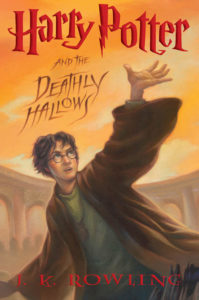
Leave a comment